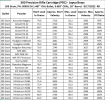I have the following spread sheet from Berger on 205 EH.
Seekins Element
22" Barrell
Lapua Brass
CCI250s probably
How would you decide what powders to shoot? 300PRC. Is there a quicker and more efficient way to find a powder node without shooting 3-5 shots every .4 grains? per a powder? That is close to 35-50 loads per powder range. Any advice would be great.
I thought about shooting 1 bullet for each node, and Chrono and looking for 2-4 bullets where there is less than 15fps spread between the powder jumps. Not sure if that's accurate.
My goal is obviosly get the fastest most accurate node possible.
Seekins Element
22" Barrell
Lapua Brass
CCI250s probably
How would you decide what powders to shoot? 300PRC. Is there a quicker and more efficient way to find a powder node without shooting 3-5 shots every .4 grains? per a powder? That is close to 35-50 loads per powder range. Any advice would be great.
I thought about shooting 1 bullet for each node, and Chrono and looking for 2-4 bullets where there is less than 15fps spread between the powder jumps. Not sure if that's accurate.
My goal is obviosly get the fastest most accurate node possible.

